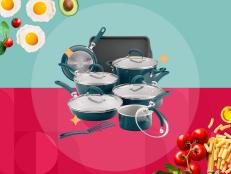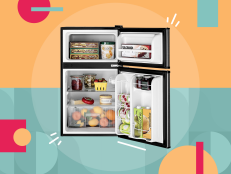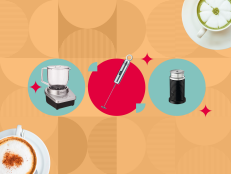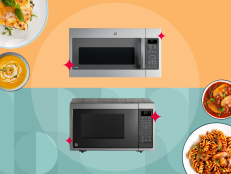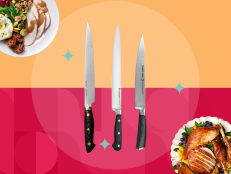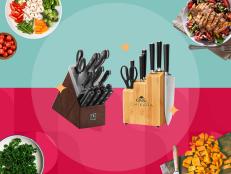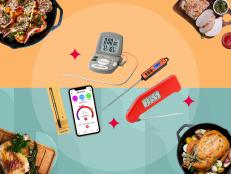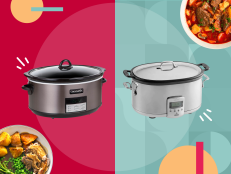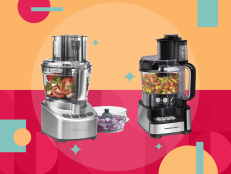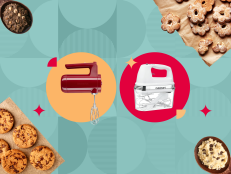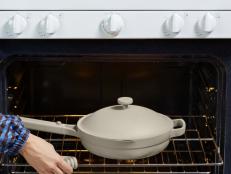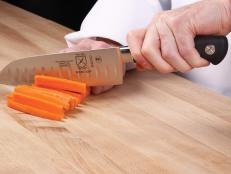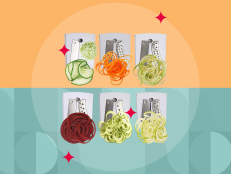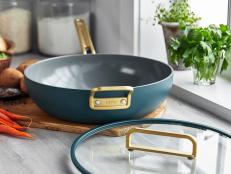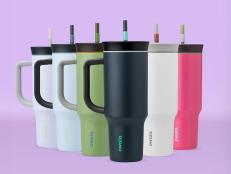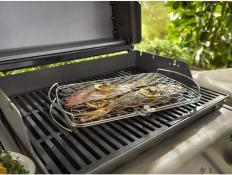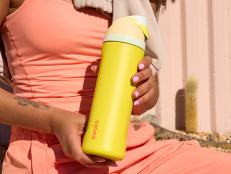7 Best Can Openers of 2024, Tested and Reviewed
We tested electric, manual, top-cutting and side-cutting can openers to find the best ones on the market.


Taylor Murray
Our Top Can Opener Picks
Also in This Article
Tested by Taylor Murray
Your can opener is probably not a kitchen tool that you think about often. We can hardly blame you when there are far more exciting gadgets, like espresso machines and pizza ovens. There's likely an old one shoved in the back of your drawer somewhere that gets used to open the odd can or bottle of beer. If yours has been giving you trouble lately, it might be time for an upgrade. There are tons of options, all designed to help you open up that can of sardines for a fancy appetizer or chickpeas for a hearty curry dinner. With so many choices on the market, we decided to try out a few different models in every category to see which were worth buying.

Taylor Murray
How We Tested
To determine the quality of each can opener, we used each one to open a couple of cans. First, we opened a standard-sized 12-ounce can of evaporated milk that measured 2 7/8 inches across. This width is a very common size that's used for everything from canned beans to tomatoes. Next, we opened a tiny six-ounce can of tomato paste that measured 2 1/8 inches across.
When evaluating can openers, we realize that most are going to function pretty similarly, so we wanted to look closely at what made the top performers stand out. We first evaluated how well each opened a can, making note of any jagged edges left from opening or bumps and slips while opening. Then, after determining which opened with the most ease and efficiency, we looked at the storage space needed, including if they required counter space or not. Finally, we washed each according to the manufacturer's directions.
- Easy to use
- Solid construction
- Built-in bottle opener
- Sometimes leaves a small thread attached
The type of can opener most people picture when they think of a can opener is the simple, manual rotary style, and this is the best version of this type. The hinge allows for a full open to accommodate any style of can, but is tight enough to stay where you want it to. We especially liked the soft grips on the handles, which were comfortable to hold and grasp. While this opener is a top-cut style that does produce a jagged edge, this specific model created a much smoother edge with fewer snags or burrs.
- Style Standard rotary can opener
- Type Manual
- Top-cut or side-cut? Top-cut
- Material Stainless steel and nonslip silicone
- Dimensions 8" x 2.25" x 2"
- Care instructions Hand wash only
- Affordable
- Safe-touch edge
- Compact
- Not dishwasher-safe; hand wash only
At under $15, it's hard to go wrong with this can opener. It operates smoothly and cleanly, leaving behind a much cleaner edge than standard can openers. Using a side-cut design, the opener clamps onto the side of the can, and your hand spins the gear around like any other manual can opener. The compact design has no hinge and minimal moving parts to break or wear out over time. The cutting edge doesn't touch food as it cuts, making clean-up minimal.
- Style Safe-cut rotary can opener
- Type Manual
- Top-cut or side-cut? Side-cut
- Material Stainless steel and plastic
- Dimensions 9" x 2.5" x 2"
- Care instructions Hand wash only
- Automatic shut off when finished
- Hands-free operation
- Smooth-cut edge
- Batteries must be replaced
Can openers that rely on batteries offer an interesting compromise between the hands-free operation of electric openers with the limitless use of a plug-in opener. Without needing to be chained to the wall, this opener can go wherever you need it to and will do its job without you being forced to stand there and hold it. This version of Kitchen Mama's battery-powered openers is the only one that has hands-free operation, which we think is one of the best aspects of an electric opener.
We also like that it isn't restricted to any size of can — it moves itself around the edge of the can so it can work with even industrial sizes. It cuts a smooth-to-the-touch edge by winding around the side of the can, and the blade never contacts the food to reduce chances for cross-contamination. The only downside is the same thing as anything else that's battery-operated: The gadget only lasts as long as the batteries do and when they run out, it won't work at all until replaced.
- Style Battery-operated, automatic can opener
- Type Electric
- Top-cut or side-cut? Side-cut
- Material Plastic and steel
- Dimensions 5" x 2.75" x 1.75"
- Care instructions Wipe clean
- Ambidextrous product
- Compact
- Built-in bottle and jar opener
- Small learning curve to operation
If you don't mind expanding beyond traditional hinged manual can openers but definitely don't want to dabble in electric models, the Bartelli Soft Edge 3-in-1 Ambidextrous Safety Can Opener is a great pick that comes in a compact size. This opener has a wide, flat shelf that you apply pressure to with one hand while your other hand turns the rotary dial to move the gears along the can. As it moves, it slices through the side of the can, leaving a smooth edge that won't cut you or tear open your trash bag.
Built into the design are a bottle opener and a handy jar opener, so it could potentially take the place of three different gadgets currently taking up space in your tool drawer. Finally, this option works for people with either handedness and could be a great choice for a home that has both lefties and righties in it.
- Style Safety rotary can opener
- Type Manual
- Top-cut or side-cut? Side-cut
- Material Plastic and stainless steel
- Dimensions 5" x 3.25" x 2"
- Care instructions Wipe with clean cloth
- Built-in blade sharpener and cord storage
- Automatic stop
- Dishwasher-safe cutting assembly
- Bulky
- Can leave a jagged can edge
There are a lot of people who might find the appeal to a plug-in electric can opener, and many available on the market today come with a lot of features to justify their larger footprint. The best ones, like this model from Hamilton Beach, have a fully automatic operation. That means that you can set a can to open and walk away. The can and the lid will hang out until you're ready to grab them. A handy magnet grabs the lid and holds it far from the can, so you don't have to worry about nicking yourself.
If you're worried about the blade dulling over time, there is a built-in blade sharpener on the back of the machine that can be used to sharpen the can opener or any other blade in your house. Unlike other electric openers we tested, the cutting assembly on this model is removable and dishwasher-safe. That's a huge plus, though ours did not get dirty during use.
- Style Electric, plug-in opener
- Type Electric
- Top-cut or side-cut? Top-cut
- Material Plastic and stainless steel
- Dimensions 10" x 5" x 4.5"
- Care instructions Wipe with clean cloth, dishwasher-safe cutting assembly
- Long-lasting and durable
- Easy to clean
- Affordable
- Slight learning curve to operation
- Can leave ragged edges on cans
Fixed can openers have no moving parts and use a pivot point, or fulcrum, to apply pressure. The blade pierces the top of the can while you use your hand to spin the can around, lifting and slicing as you go around. This style of opener does create ragged edges, but no more so than some of the other manual or batter-powered openers we tested. This might be worth putting up with if you are looking for an opener that you never have to replace. No moving parts means nothing to wear out, jam or break over time. The design is ultra-flat and compact, so you could throw it in your bag for a day at the beach or an overnight camping trip. There's a bottle opener built into the handle that could also easily be looped onto a carabiner.
- Style Manual fixed can opener
- Type Manual
- Top-cut or side-cut? Top-cut
- Material Enameled stainless steel
- Dimensions 2.5" x 4.25"
- Care instructions Hand wash only
- Ultra-compact
- No sharp edges
- Fast operation
- Could be difficult to use for those with mobility issues
- Slight learning curve for first-time users
If space is your primary concern, you might be happy to know that there is a can opener designed for you in mind. This option from Joseph and Joseph is barely bigger than the lid of a standard can, but functions just as easily. To use it, you just place the opener on top of the can and a wheel grabs onto the edge and starts cutting as you turn a dial that's shaped similar to a kitchen timer. During testing, the first use was a touch awkward due to our lack of familiarity with this style, but once we had it figured out it was super-fast and efficient to use. The blade cuts the side instead of into the top so there were no sharp edges at the end, and the blade did not puncture into the food so not much to clean.
- Style Manual rotary style opener
- Type Manual
- Top-cut or side-cut? Side-cut
- Material Plastic and stainless steel
- Dimensions 2" x 2.5" x 2.5"
- Care instructions Hand wash only
What to Consider When Buying a Can Opener
- Type: Most people have a manual-style can opener, which uses pressure and a round blade to cut into the top of the can. Some cut into the top, whereas others cut off the entire top, rim and all. All of these require two hands and your own physical power to turn the blade around the can. Some manual can openers are one solid piece, known as fixed, and use a pressure point to force a blade down into the can while the user spins the can around after each cut. Electric can openers use batteries or a wall plug to cut into the can. Most use a magnet system to hold onto the can so that the machine completes the entire process with the push of a button. These can be a great option for those with mobility issues or who hate fiddling with the manual variety.
- Style: Can openers employ one of two styles to open cans. Top-cut openers are very common and clamp to the top of the can, puncturing the lid and forcing the blade to cut around the top lip while turning. This method of opening often leads to sharp edges. When done correctly, this method can take the least amount of effort and be more intuitive to use. Side-cut openers clamp along the side of the can with the blade pushing against the rim of the can, cutting sideways. Clamping can take a bit more effort depending on the design, but, once clamped, the can opener is very stable and barely needs support or guidance. This method leaves no cut, or sharp edge and removes the top of the can completely.
- Ease of Use: While can openers might seem foolproof, not all styles are inherently easy to use. Most people are familiar with the common style of manual, rotary openers, though some of these styles did not give us a smooth experience going around the can and jumped off the track, so to speak. Some of the electric style can openers require you to do a quick read of the manual before first use but can be a breeze once you get it down. Choosing the right option might come down to personal preference and ability level.
- Care & Maintenance: Most can openers are not going to be dishwasher-safe. Blades in general don't do well in the harsh environment of the dishwasher and are known to rust or dull over time. Some electric can openers have a removable blade apparatus that is dishwasher-safe.

Taylor Murray

Taylor Murray

Taylor Murray

Taylor Murray
Frequently Asked Questions
How do you clean a can opener?
Most can openers can be cleaned by washing with soap and water, often just a quick rinse to remove sticky residue will be more than enough. Always check the manufacturer's instructions of your can opener for specific information.
How do you sharpen a can opener?
A quick and simple way to sharpen a can opener is to cut through several layers of aluminum foil as if opening a can, which can help hone the blades. Alternatively, cut through fine-grit sandpaper or carefully run a small sharpening stone along the blade. Some electric can openers feature a built-in sharpener to hone the blade.
How do you prevent a can opener from rusting?
The best way to prevent a can opener from rusting is to dry it thoroughly after each use. Rust can't form if there isn't any moisture left on the blade or parts.






































